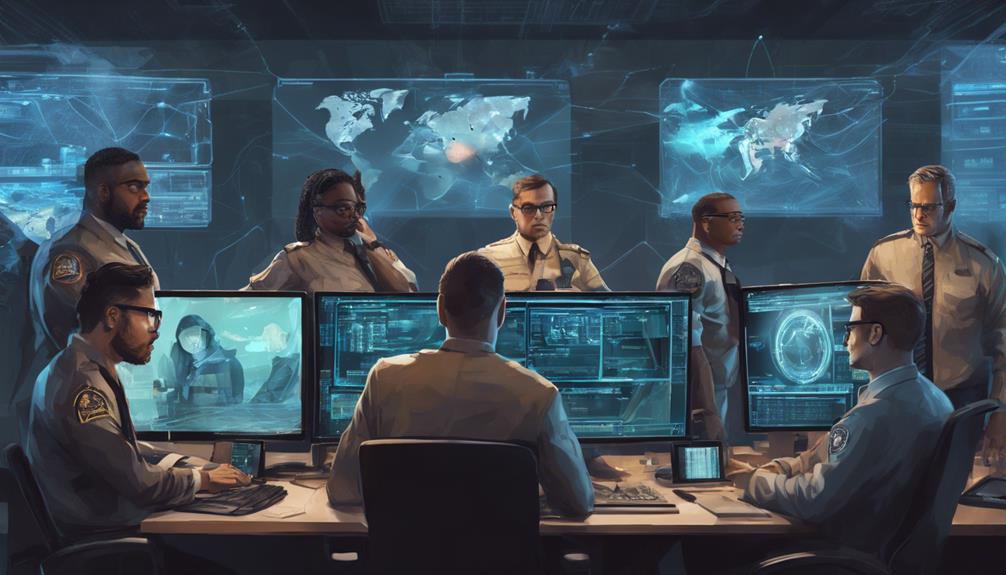Protecting data in the cloud involves robust security measures like encryption, access controls, and compliance certifications. Common hacking techniques include phishing, data breaches, and malware injection. Implementing multi-factor authentication and employee training enhances security. Continuous monitoring and proactive measures, such as regular updates and encryption, are crucial. Overall, securing the cloud requires a layered approach to combat cyber threats effectively.
Key Takeaways
- Encryption protects data integrity and confidentiality in the cloud.
- Access controls and authentication protocols restrict unauthorized entry.
- Regular security audits monitor vulnerabilities and ensure compliance.
- Multi-factor authentication enhances cloud security against hackers.
- Continuous monitoring detects and mitigates security threats in real-time.
Cloud Security Measures Overview
Cloud security measures encompass a range of protocols and practices designed to safeguard data stored in the cloud from unauthorized access and breaches. Encryption plays an important role in protecting data integrity by converting information into a code that only authorized users can decipher.
Strong access controls and authentication protocols further enhance security by restricting entry to authenticated individuals, ensuring that sensitive data remains protected. Cloud providers conduct regular security audits to monitor and assess potential vulnerabilities, mitigating risks and ensuring data safety.
Compliance certifications such as GDPR and HIPAA are essential components of cloud security measures, as they establish guidelines for protecting data privacy and maintaining regulatory standards. Additionally, redundant storage systems in the cloud contribute to data availability and durability, ensuring that information remains accessible even in the event of hardware failures.
Implementing these best practices strengthens cloud security, offering users a robust framework to safeguard their valuable data from potential threats.
Common Cloud Hacking Techniques

Common cloud hacking techniques encompass a range of malicious activities employed by cybercriminals to breach cloud systems.
Phishing attacks aim to trick users into revealing sensitive information, while data breaches involve unauthorized access to confidential data.
Additionally, malware injection involves planting malicious software to compromise cloud security measures.
Phishing Attacks
Phishing attacks, a prevalent technique in cloud hacking, involve deceiving users into divulging sensitive information through fraudulent means such as emails and websites designed to appear legitimate. These attacks aim to exploit human vulnerabilities rather than technical flaws in cloud systems.
By using social engineering tactics, hackers manipulate individuals into clicking on malicious links or providing confidential data. To combat phishing attempts effectively, it is important for users to be educated on how to recognize such fraudulent activities.
Implementing multi-factor authentication adds an extra layer of security, requiring users to provide multiple forms of verification before accessing their accounts, hence thwarting many phishing attacks.
As the sophistication of phishing techniques continues to evolve, staying informed about the latest trends in cyber threats and regularly updating security measures are essential steps in safeguarding sensitive information stored in the cloud.
Data Breaches
Data breaches in cloud systems often occur due to various hacking techniques that exploit vulnerabilities in security protocols and user behaviors. Hackers target cloud computing environments to gain unauthorized access to stored data, posing significant risks to cloud security.
Common hacking methods, such as phishing attacks and brute force password cracking, are frequently utilized to breach cloud systems and compromise sensitive information. Additionally, misconfigurations in cloud setups can be exploited by hackers to access confidential data.
SQL injection and cross-site scripting are prevalent techniques used to compromise cloud security, along with weak encryption practices and insecure APIs that create vulnerabilities. Insider threats, where employees either intentionally or unintentionally leak sensitive data, also contribute to the risk of data breaches in cloud environments.
Protecting sensitive data stored in the cloud requires robust security measures to mitigate these potential security threats and safeguard against unauthorized access.
Malware Injection
One prevalent technique employed by hackers to compromise the integrity of data in cloud systems is malware injection. Hackers use malware injection as a means to exploit vulnerabilities in cloud infrastructure, potentially leading to data breaches and unauthorized access.
Malicious software injected into the cloud can spread rapidly, affecting multiple users and causing widespread damage. To combat this threat effectively, implementing prevention measures is essential. Regular security audits and timely software updates play a significant role in mitigating the risks associated with malware injection in cloud environments.
Additionally, educating users on how to detect and avoid malware, coupled with robust endpoint security measures, can enhance defenses against malware injection attacks in the cloud.
- Malware injection compromises data integrity in cloud systems.
- Exploiting vulnerabilities can lead to data breaches and unauthorized access.
- Malicious software can spread quickly, causing widespread damage.
- Prevention measures such as security audits, updates, user education, and endpoint security are essential to mitigate malware injection risks.
Importance of Multi-Factor Authentication

Multi-factor authentication (MFA) plays an important role in bolstering security measures against potential breaches in cloud environments.
By requiring multiple forms of verification, such as passwords, biometrics, or physical devices, MFA greatly reduces the risk of unauthorized access even if one factor is compromised.
Implementing MFA is a proactive step that enhances protection for sensitive data and accounts, making it an essential practice in safeguarding against cyber threats.
Enhanced Security Measures
Enhancing cloud security through the implementation of multi-factor authentication is essential in safeguarding sensitive information and thwarting unauthorized access attempts.
Multi-factor authentication (MFA) adds an extra layer of security by requiring users to provide two or more verification factors, such as passwords, security tokens, biometric data, or a mobile device verification code.
In the cloud infrastructure, MFA plays a vital role in preventing unauthorized access even if passwords are compromised. This security measure greatly reduces the risk of data breaches and unauthorized account access, making it a best practice recommended by cybersecurity experts.
Protection Against Breaches
In the domain of cloud security, safeguarding sensitive information against potential breaches demands the implementation of robust multi-factor authentication measures. Multi-factor authentication (MFA) adds an extra layer of security by requiring users to verify their identity through multiple methods, such as passwords, codes sent to mobile devices, or biometric verification.
This greatly reduces the risk of unauthorized access, even if passwords are compromised. Cybersecurity experts recommend implementing MFA as a best practice to enhance cloud security and protect sensitive data from potential breaches.
Employee Security Training Benefits

Employee security training is a critical component in reducing the risk of data breaches and enhancing overall cybersecurity measures within an organization. Proper training equips employees with the knowledge and skills to identify and respond to potential threats effectively.
Here are some key benefits of employee security training:
- Reduction in Data Breach Risk: Training can decrease the likelihood of data breaches by up to 70%, greatly enhancing the organization's security posture.
- Phishing Email Awareness: Employees learn to recognize phishing emails, a common tactic used in cyber attacks, thereby reducing the chances of falling victim to such threats.
- Protection of Sensitive Information: Educated employees are better equipped to handle sensitive information securely, minimizing the risk of data leaks or unauthorized access.
- Enhanced Security Protocols: Training programs instill a culture of following security protocols, contributing to a more secure environment and mitigating insider threats effectively.
Continuous Monitoring Best Practices

Effective cloud security requires implementing continuous monitoring best practices to proactively identify and mitigate security threats in real-time.
Continuous monitoring involves the real-time tracking of cloud infrastructure to detect unauthorized access, security threats, and potential vulnerabilities promptly. By utilizing monitoring tools like intrusion detection systems and security information and event management (SIEM), organizations can enhance their incident response capabilities and overall security posture.
These tools provide automated alerts and notifications, enabling security teams to respond swiftly to any security incidents that may arise. Regular monitoring not only helps in identifying and addressing security issues promptly but also aids in preventing potential breaches and data leaks.
It is essential for organizations to invest in continuous monitoring best practices to safeguard the safety and integrity of their cloud environments.
Proactive Measures for Cloud Safety

To enhance the security of cloud environments, organizations should prioritize implementing proactive measures to mitigate potential risks and safeguard sensitive data.
These measures include:
- Regularly updating security controls and conducting vulnerability assessments to identify and address weaknesses promptly.
- Implementing multi-factor authentication to bolster defenses against unauthorized access attempts.
- Utilizing encryption for data at rest and in transit to protect sensitive information from potential breaches.
- Educating employees on best practices for cloud security to minimize the risk of human error leading to security vulnerabilities.
Frequently Asked Questions
How Safe Is the Cloud From Hackers?
The safety of the cloud from hackers is a critical concern given the potential for data breaches, user errors, and shared infrastructure vulnerabilities. Robust security measures and proactive practices are essential to safeguard sensitive information.
Is My Stuff Safe in the Cloud?
Your data in the cloud is safeguarded through encryption and stringent security measures, minimizing the risk of unauthorized access. Opt for reputable providers with strong security protocols to guarantee the safety of your information.
Is the Cloud Safe for Personal Information?
The safety of personal information in the cloud depends on encryption, secure storage methods, strong passwords, multi-factor authentication, secure connections, redundancy, expert security teams, regular audits, and compliance certifications. These measures guarantee data protection and privacy.
What Are the Security Risks of Cloud?
Exploring the labyrinth of cloud security entails recognizing the multifaceted risks: data breaches stemming from vulnerabilities, user errors, shared infrastructure susceptibility, and global data exposure. Vigilant risk management is imperative for safeguarding against potential threats.
Conclusion
In summary, while the cloud offers many benefits, it is essential to implement robust security measures to protect against hackers.
By utilizing multi-factor authentication, providing employee security training, and implementing continuous monitoring practices, organizations can enhance their cloud safety.
One example of the importance of cloud security is the 2019 Capital One data breach, where a hacker gained access to over 100 million customer records stored in the cloud, highlighting the need for stringent security measures.









